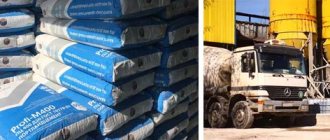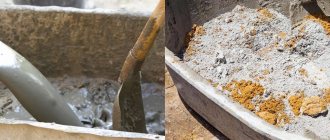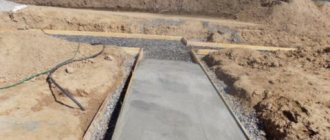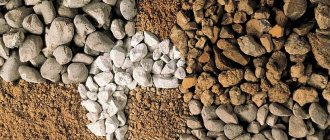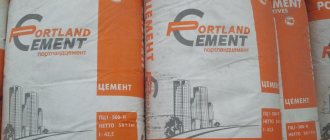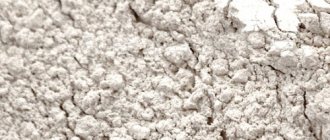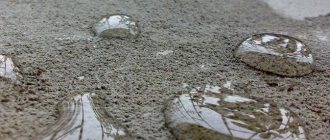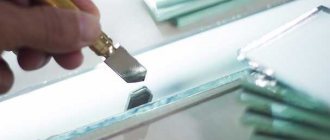Home |Construction |How to make concrete mortar correctly?
Date: November 14, 2017
Comments: 0
Concrete is used in the construction industry for various activities. It is in demand when constructing foundations, building buildings, pouring screeds, concreting blind areas, as well as manufacturing reinforced concrete products. With increased volumes of work, the finished composition is ordered from specialized enterprises, which is associated with an increased consumption of financial resources. However, you can save a lot by knowing how to make a concrete solution yourself. It is important to follow the recipe and choose the right ingredients to ensure strength.
Characteristics of concrete mixture
When planning the construction of a private house and wondering how to make a concrete solution, it is necessary to study its properties. This is a mandatory requirement to obtain a quality mixture.
Concrete strength ratio table
The provisions of the current standard regulate the main operational characteristics of the composition:
- strength.
The indicator characterizes the ability of a concrete mixture to resist compressive forces and is measured in megapascals. Strength is indicated by the letter B together with a digital index, the value of which is 3.5–80. The strength value corresponds to the pressure at which the integrity of the reference sample is maintained. Concrete compositions are divided into certain classes and grades. The material is marked with the letter M and a digital value from 50 to 1000, which indicates the load per square centimeter of surface expressed in kilograms. Compositions marked M100–M150 are used for lightly loaded structures, and M250–M400 and higher are used for critical work; - plastic.
This is a serious parameter of the concrete mixture. With increased mobility of the mixture, it better fills the space and does not allow voids to form. This property is relevant when pouring formwork and concreting critical structures in which unfilled areas are not allowed. The cavities of the concrete mass can cause premature destruction of the monolith. Depending on the tasks, solutions are used that differ in the degree of plasticity. Rigid compositions are marked with the letter Zh, flexible mixtures - P, and with increased fluidity the designation contains the letter P. To effectively fill hard-to-reach areas, a composition with the grade P-4 is used, and for standard designs P-2, as well as P-3;
Concrete is an artificial stone material obtained by mixing binders with aggregates and water.
- frost resistance.
This parameter characterizes the ability of a concrete mass to maintain integrity under the influence of temperature changes associated with deep freezing and further thawing. Resistance to negative temperatures is indicated by the Latin letter F together with a digital index. The minimum number of cycles during which the concrete mass does not become covered with cracks is 25, and the maximum possible is 1000. In order to increase frost-resistant properties, specialists introduce special plasticizing additives, which also reduce the setting time; - waterproof.
Characterizes the ability of a hardened monolith to resist the penetration of moisture deep into the massif. Resistance to moisture saturation is determined by the brand of Portland cement used, as well as its percentage. Water resistance increases when using high grade Portland cement. The characteristics are designated by markings that include the letter W and numbers. The digital marking indicates the maximum pressure of the water column at which the reference sample retains its original moisture content. According to the standard, the minimum water resistance value of concrete mortar is W2, and the maximum is W20.
Due to its improved performance characteristics, the material is in demand in the construction industry and successfully competes with natural stone.
Requirements for concrete components
Cement
Cement is the main and only ingredient of concrete that binds all components together. Portland cement is the most suitable for preparing concrete. It is distinguished by an increased and prevailing content of calcium silicates (up to 78-80%), which ensures improved adhesion and bonding of materials. However, depending on the task at hand, other types of cement are also used.
The most suitable grade of cement for private construction is 500. You can also use standard M400, but this will affect the durability of the same foundation.
In addition to good adhesion, Portland cement is better suited for working at low temperatures. Even so, you cannot work with concrete at temperatures below 16 degrees. If there is a good reason to use concrete at lower temperatures, then special additives and plasticizers will be required, but more on that later. For work in hot weather, Portland slag cement is better suited.
In the domestic marking of cement, in addition to the designation of its declared strength in the same MPa, which is marked as a brand, there is also the designation “D”, after which a number is placed indicating the amount of foreign impurities in the cement. Actually, for the preparation of high-quality concrete, cement M500-D0 or M500-D20 is suitable, that is, with impurities from 0 to 20%.
The cement must be dry and free-flowing. Under no circumstances should you purchase damp or lumpy cement, and you should also not save too much and buy unlabeled, stale or discounted cement. After all, concrete will be used to construct important elements of the house, so your well-being and safety depend on it. In unsuitable conditions, cement can very quickly absorb moisture from the air and lose a significant part of its qualities.
It is better to purchase the required amount of cement a maximum of 2 weeks before direct use or a few days in advance. Check the presence of markings and the integrity of the packaging.
Sand
Regardless of the aggregate used, crushed stone or gravel, sand will also be required. Only in some cases do they do without it, when it is possible to compact and select large aggregate so that the gaps between all components are minimal.
Sand suitable for preparing concrete should have a fraction of 1.5 to 5 mm, best when it has a uniform size with a variation of no more than 1-2 mm. The sand should not contain foreign impurities. All kinds of plant debris, construction debris and any inclusions that may disintegrate or rot over time will adversely affect the strength of concrete. To be on the safe side, if the sand is not completely clean, it is better to pass it through a sieve with fairly small cells. Actually, the same applies to crushed stone.
River sand is best suited; although it is more expensive than gully sand, it has a suitable grain size and does not contain silt inclusions or clay. Unlike cement mortars, which are used for the construction of brickwork or plastering, in which the presence of clay can only help, because it will be easier to level it, it is not permissible in concrete. It is important to ensure maximum adhesion of the cement mortar with large aggregates, which determine the overall strength of concrete. So it is better not to use sand with loam or grains less than 1 mm at all for preparing concrete, because it is very difficult to get rid of them. To do this, they use the procedure of washing and settling the sand, which, even in industrial conditions, is not always profitable or easy.
Alternatively, for areas near which there are stone quarries, artificial heavy sand can be used. It is obtained as a result of crushing rocks and is characterized by greater mass and density. If it is washed properly and separated by particle size, it will be even slightly better than river sand. It is only important to take into account when preparing and when using that the concrete will turn out to be much heavier; this is important if it is used in the construction of screeds over interfloor ceilings. A significant obstacle to the use of heavy artificial sand may be the possible increased background radiation, which depends on that of the parent rock.
Aggregate. Crushed stone, gravel
The main strength of concrete comes from filling it with gravel or crushed stone. Sea or river pebbles are in no way suitable, because their surface is polished with water and does not provide proper adhesion to the solution. The best material is obtained from crushed rock.
It is important to take into account the characteristics of the breed that was used. Expanded clay or other similar materials are also often used, which are quite strong, but at the same time light. Below we will consider the principle by which you can select the appropriate material for preparing concrete, which will provide the necessary strength and reliability for specific situations. The size of gravel or crushed stone can vary from 8 to 35 mm; larger pieces are used mostly in production, and even then rarely. As with sand, it is desirable that the aggregate contains as little dust or clay inclusions on its surface as possible. The debris must be picked out before the gravel goes into the solution. The higher the roughness on the particle faces, the better. Reliable grip depends on this.
To prepare concrete yourself, it is better to choose either an aggregate, which itself has particles of several sizes, or mix coarse gravel with medium gravel. In the absence of professional equipment for compacting concrete, this will ensure a tighter fit of the aggregate particles to each other and will prevent the formation of large voids. Otherwise, the latter will be filled with mortar, and this will affect both the strength of the concrete and the consumption of the mortar itself.
For storage, it is better to store both sand and crushed stone or gravel in bulk near the place of use. In order to prevent contamination of materials and moisture from the soil, it is better to place the embankments on a spread tarpaulin or an area with a solid base. In the simplest case, when materials are poured directly onto the soil, the lowest layer that is in contact with it should not be used.
Water
The moment of choosing water is very important. There is, of course, no question of using any special water. However, it must be clean and free of alkaline or acidic foreign matter. You cannot use river or, especially, lake water, which contains more than enough inclusions. It is best to follow a simple rule: water that is suitable for drinking is also suitable for making strong and good concrete at home. Only by following this rule can you expect that the concrete will be durable and last a long time without any damage or destruction.
Supplements
- Lime. Some craftsmen add a little slaked lime to the concrete composition, this increases the workability of the solution. This somewhat facilitates the process of leveling the surface of the concrete screed or cast section of the porch or outlet. And yet, in addition to this, lime can interfere with the normal bond between cement and aggregate, which will affect the strength. The choice of whether to resort to using lime or not remains with the master, when he knows exactly what is best at the moment. There is no need to extinguish lime yourself for a long time now. Instead, ready-made slaked lime is used, which is sold in construction stores and is called fluff.
- Plasticizers. To give the concrete solution greater fluidity or reverse viscosity, various plasticizers are used, which change the properties of the solution in a given direction. The use of plasticizers can increase or decrease the amount of water required to prepare the solution. For work such as pouring a foundation, plasticizers may not be used, but they can play an important role if the reinforcement is quite dense or the foundation has a complex shape. At the same time, more fluid concrete will fill all voids and branches faster and more reliably, which will speed up the process and improve the result.
Plasticizers for concrete
- Auxiliary components. In addition to the above, special additives can be used to impart more advanced properties to concrete. Thus, additives can be used to ensure that concrete sets and hardens at low temperatures or in the presence of large amounts of moisture. Appropriate additives are used for various purposes. It is important to decide whether to use them and select the necessary additive at a hardware store. Carefully study the instructions for use and properties of the additive. If the conditions in which concrete will be used have limiting parameters in terms of temperature or humidity, then additives and plasticizers will be indispensable.
- Reinforcing substances. In addition to concrete aggregate, specific additives are often used for additional reinforcement. So, when using concrete, a special polypropylene or polyvinyl chloride fiber is used to make a fairly thin screed. It itself is soft and not particularly strong, but it will help avoid situations where concrete cracks at the points of convergence of floor slabs or in the case of an unstable base when forming the main floor on top of soils.
Durable concrete - mixture composition
Everyone knows that concrete is made from cement. However, the strength characteristics and properties are affected by all the components used:
- Portland cement.
It is used as a binder, which ensures the combination of the remaining ingredients of the solution in the hardened mass. The strength of the concrete monolith depends on the quality of cement. In private and industrial construction, Portland cement is used, marked M400 and higher. It is important to pay attention to the production date of cement, which loses its properties with high humidity or long-term storage;
Concrete Components Table
- sand.
After cement, this is the second most important ingredient added to a concrete mixture. In certain situations, it can be replaced with slag. But according to the requirements of the standard, sand must be present in the mixture. The use of river sand with increased grain size ensures an increase in strength characteristics in the absence of impurities in the sand fraction. It is allowed to use a fine sand fraction without foreign inclusions that impair adhesion; - aggregate.
Traditionally, the concrete mixture contains crushed stone, the size of which is 0.5–3.5 cm. Crushed stone can be replaced with gravel, as well as expanded clay granules. An increased coefficient of adhesion between the aggregate and the binder is achieved due to its rough surface. The aggregate must be pre-screened onto a tarpaulin or clean base to remove debris; - special additives.
The introduction of plasticizing substances allows you to change the performance properties of the material. This increases resistance to negative temperatures, water resistance, and also increases the plasticity of the concrete solution. The use of plasticizers is justified when it is necessary to perform work in conditions of negative temperatures, as well as when concreting in a humid environment. Reinforcing fibers are also introduced to protect the array from cracking.
In addition, water is added to the mixture. The concentration of these components in concrete varies depending on the required strength of the material.
You can make a concrete solution yourself - manually or using a concrete mixer
Characteristics of concrete
Concrete mix components
Strength
Concrete mortar is a mixture of cement, sand, filler and water in certain proportions, which vary depending on the purpose of the concrete and the brand of cement. If necessary, plasticizers are added to the solution. The most important characteristic of concrete is its compressive strength, which is measured in MPa (mega pascals). It is based on this indicator that concrete is divided into classes. But the grade of concrete indicates the amount of cement in the solution.
We recommend: How to make a bath font with your own hands, wooden and from other materials - step-by-step instructions with photos, videos, dimensions and drawings
Concrete class Average strength of this class, kg s/sq. cm Nearest grade of concrete
| AT 5 | 65 | M 75 |
| B 7.5 | 98 | M 100 |
| AT 10 | 131 | M 150 |
| At 12.5 | 164 | M 150 |
| At 15 | 196 | M 200 |
| IN 20 | 262 | M 250 |
| At 25 | 327 | M 350 |
| At 30 | 393 | M 400 |
| At 35 | 458 | M 450 |
| At 40 | 524 | M 550 |
| At 45 | 589 | M 600 |
| At 50 | 655 | M 600 |
| At 55 | 720 | M 700 |
| At 60 | 786 | M 800 |
Concrete grades M100 and M150 (B7.5 and B12.5) are most often used as a layer under the main foundation, for the manufacture of screeds, and concreting paths. Concrete M200-M350 is most in demand: it is used in the construction of foundations, for the manufacture of screeds, concrete stairs, and blind areas. Mortars of higher grades are used primarily in industrial construction.
Basic characteristics of concrete
Water
The water should be as clean as possible, without impurities, dirt, clay, or soil. You cannot take wastewater from swamps, stagnant springs, or chemically contaminated wastewater. The solution simply will not set well. On average, water needs half the mass of cement.
Never add water to a ready-made solution.
Filler
There is a fine filler - sand, and a coarse filler - gravel, crushed stone. For light mixtures - expanded clay filler, slag, brick or limestone crushed stone. There is a rule: the strength of a coarse filler is two to three times greater than the design strength of the finished mortar. Crushed stone creates a kind of power skeleton for the mixture.
The filler should be as clean as possible, without soil, branches, soil, and especially clay. It is sometimes washed and sieved at the construction site. Allowable amount of impurities: 35% for crushed stone, 5% for sand. Organic impurities destroy the solution from the inside. It is recommended to sift, rinse and dry the filler before use.
Plastic
An important characteristic of concrete is its plasticity. The more plastic the solution, the better it fills the formwork structure. When the mobility of concrete is low, unfilled areas remain in the screed or foundation, which leads to the gradual destruction of the concrete slab. For standard structures, concrete with plasticity P-2 or P-3 is used; for formwork of complex shapes and in hard-to-reach places, it is recommended to use a solution P-4 and higher.
Waterproof and frost-resistant
Water resistance depends on the amount and brand of cement in the solution. The higher the grade, the more resistant the concrete is to moisture. Frost resistance of concrete is achieved by adding plasticizers to the composition. It should be noted that such solutions set very quickly; if you incorrectly calculate the amount of the mixture or use it at a low temperature, the concrete will turn into a monolithic block right in the container.
How to make concrete correctly - mortar proportions
When preparing a concrete composition yourself, you need to know how to make concrete from cement, the strength of which corresponds to the tasks set.
Follow these guidelines:
- mix sand, cement and crushed stone, maintaining a ratio of 3:1:6;
- add water in limited portions, controlling the density of the mixture;
- use the same container to measure the volumes of components;
- add water in a ratio of 1:2 to the total volume of dry ingredients.
Pay attention to the moisture concentration in the sand. At high humidity, less water must be added.
When preparing concrete, remember to change the proportions of sand, cement and crushed stone in accordance with the required grade of composition:
- 3.5:1:5.7 – corresponds to M150 concrete;
- 2.8:1:4.8 – proportions for mixture M200;
- 1.9:1:3.7 – ratio for M300 solution;
- 1.2:1:2.7 – proportion of components for M400 concrete.
Using tables posted on specialized websites, it is easy to calculate the proportions and correctly prepare the composition.
Any mortar consists of binders, water and aggregates - small and large
Selection of ratios of materials for preparing concrete
Different purposes require different concrete compositions. So, to form a foundation for a house, you need strong concrete with the inclusion of large crushed stone with elements ranging in size from 20 to 35 mm, and the amount of mortar is sufficient to fix the aggregate. In this case, the solution must be fluid, because it is necessary to firmly compact the concrete and remove all air bubbles from it. However, before pouring the main part of the concrete, you should equip the substrate. For this purpose, the easiest to prepare and less durable concrete, B7.5, is used, which in addition to cement mortar may contain only coarse sand. Moreover, for this purpose the concrete solution is not made liquid, but more similar in consistency to wet soil.
To construct foundations, you will need an average size fraction of filler and still a liquid solution. This will ensure ease of distribution of the solution over the surface in a fairly thin layer. Also, the fine and medium fraction of the aggregate is indispensable when forming elements such as balusters, decorative elements or garden utensils and fills, small elements such as a porch or steps.
The composition of concrete in terms of ingredients and their ratio must be carried out in accordance with GOST 7473-94 and SNiP 5.01.23-83. This takes into account the density of each of the ingredients used and the required average density of concrete, which is necessary in a particular situation. After the weight and volume ratios of the ingredients have been calculated, you can begin the planned preparation and pouring of concrete.
The most common proportions of concrete are 1:3:6 parts, respectively, of cement, sand and aggregate and 0.5-1 part of water, depending on the required fluidity of the solution. However, more often than not, adhering to such a layout results in an unsatisfactory concrete result, and this will be visible only after a while, when it will be quite difficult to correct anything. It is best, in accordance with the presented regulatory documents, to perform an essentially simple calculation and protect yourself from unpleasant consequences. All this is due to the fact that both aggregate and sand, and cement, can vary significantly in density parameters and bonding characteristics.
After the calculations, you should decide on a practical method for measuring the ingredients. After all, we now only have volumetric and weight parameters, and they are somewhat incompatible with those in a real situation. The same sand can be quite wet or excessively loose, so that a 10-liter bucket will contain far less than the weight that would be expected from calculations of the density-to-volume ratio.
In terms of the moisture content of the same sand and gravel, it is better to dry them than to try to roughly calculate the number of servings of a particular ingredient. And to determine the looseness and the removal of portions, it is enough to weigh the portions of each ingredient in relation to one volume. That is, take a bucket or other convenient container and fill it without compacting it with sand, cement and filler alternately, and weigh the resulting portion. Then, through simple calculations, it will be possible to convert the previously obtained calculations into the ratio of buckets.
How to make concrete by hand
A number of developers use purchased concrete. Unfortunately, not everyone knows how to make it by hand. But with a limited need for concrete, the manual method is more convenient.
This is a simple process, for which you need to prepare:
- spacious container;
- shovel or bayonet shovel;
- standard buckets;
- an ordinary hoe or glander.
Algorithm of actions:
- Fill the prepared container with the ingredients, previously measured in accordance with the recipe used.
- Mix the dry ingredients in the container evenly using the tool.
- Gradually adding a small amount of water, mix vigorously until the required consistency.
When performing work, try to mix the components evenly and avoid dry lumps in the corner areas. If the solution becomes too thick, add water. When properly prepared, the concrete solution should not delaminate and slowly move along the inclined plane of the shovel.
To prepare the solution, a measured amount of sand and cement is poured into a trough and thoroughly mixed with a shovel.
Handmade recipe
Let's consider the option of how to prepare a concrete mixture for home construction manually, based on the proportions in the tables. Here are two tables, using which you can determine the proportions and number of components for 1 cubic meter of solution.
Table of water-cement ratio (average indicators of aggregates):
Table - Ratio of water and cement
| Concrete, brand | V/C | |
| Cement M400 | Cement M500 | |
| 100 | 1.04 | — |
| 150 | 0.86 | — |
| 200 | 0.70 | 0.80 |
| 250 | 0.58 | 0.66 |
| 300 | 0.54 | 0.62 |
Calculation of water for filler per cubic meter. m and the percentage of sand in it.
Table - Ratio of sand, crushed stone and water
| Crushed stone, mm | Volume of sand in% in solution | Water per cubic meter, in l. |
| 10-12 | 54 | 231 |
| 15 | 51 | 221 |
| 20 | 48 | 201 |
| 25 | 45 | 196 |
| 40 | 42 | 186 |
| 50 | 40 | 178 |
| 70 | 36 | 168 |
You also need to know the approximate density of the fillers, weight in kg/m2:
- for gravel filler – 1600;
- for crushed granite – 1500;
- for quartz sand – 1500;
- for expanded clay - 600–800;
- for cement - 3000–3200 (bulk -1300 ÷ 1800).
We recommend: How to store potatoes in an apartment in the summer and not only, where is it better and in what way
Preparation of concrete M300 (1 cubic m). Ingredients:
- crushed stone with a fraction of 25 mm;
- medium-grained sand;
- Portland cement M400.
The first table determines W/C - 0.54; the second is the amount of water, with this filler you need 196 liters. Cement: 196/0.54=363 l. Volume and percentage of filler: 1- ((363/3000)+0.196)=0.680 m3. We look at the percentage of sand according to the second table - 45%, which comes out to 680 × 0.45 = 306 liters of sand. Crushed stone: 680–306=374 l.
The volumes were determined in liters, so you can work with a 10 liter bucket. If the supplier measures fillers in tons, then it is easy to convert them into liters using the above weight-volume density values in kg/m2 (for cement you need to take the bulk density).
How to properly make concrete mortar in a concrete mixer
Using a concrete mixer located next to the work site, you can speed up the work and facilitate the process of preparing concrete mortar.
When mixing concrete using a concrete mixer, follow the sequence of operations:
- Pour some water into the working container of the mixer.
- Fill in the required volume of Portland cement.
- Add sifted sand.
- Mix the ingredients for five minutes.
- Add other components, including plasticizers, if necessary.
- Add crushed stone and mix for 8-10 minutes.
If the resulting solution is too thick, you can add water and mix again. It is not advisable to mix for more than 15 minutes, since the cement may gradually harden. The prepared solution is ready for use. It is easy to transport it to the work site using a wheelbarrow.
Proportions of concrete by grade
| Concrete grade | Materials kg. (share) per 1 cubic meter of concrete | |||
| Cement (grade 400) | Crushed stone | Sand | Water (l) | |
| M75 | 170 (1) | 1053 (6) | 945 (5,4) | 210 (1,2) |
| M100 | 210 (1) | 1080 (5) | 870 (4) | 210 (1) |
| M150 | 235 (1) | 1080 (4,6) | 855 (3,6) | 210 (0,9) |
| M200 | 286 (1) | 1080 (3,8) | 795 (2,8) | 210 (0,7) |
| M250 | 332 (1) | 1080 (3,3) | 750 (2,3) | 215 (0,65) |
| M300 | 382 (1) | 1080 (2,8) | 705 (1,9) | 220 (0,6) |
Concrete grades and their application
- Concrete grade M75 is the least durable. Suitable for making columnar foundations of wooden houses.
- Concrete grade M100 is used for laying basement walls in wet soils, for road work, as well as for the construction of columnar foundations of small structures with walls made of brick or sawdust concrete, slag concrete and wood concrete.
- Concrete grade M150 is used mainly for forming screeds, pouring floors, and constructing pedestrian and garden paths.
- Concrete grade M200 is already more durable, therefore it is suitable for a wide range of construction work: laying foundations of various types, creating retaining platforms and walls, making stairs and concrete pads for curbs.
- Concrete grade M250 is more durable than M200, but is used mainly for the same purposes. Also used in the manufacture of light-loaded floor slabs.
- Concrete grade M300 is the most durable of the options presented. Used for the manufacture of monolithic foundations, staircases, sewer wells and monolithic floor slabs for multi-storey buildings.
